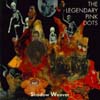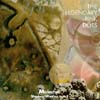The Legendary Pink Dots, "Shadow Weaver" & "Malachai"
With the reissues of these two classic LPD albums, Soleilmoon has finally finished the project of bringing the old PIAS titles back into print. Both albums feature the album cover artwork of Babs Santini yet only the second part, 'Malachai' was actually produced by Steven Stapleton. Originally released in 1992, 'Shadow Weaver' was the first album to be recorded since the untimely death of guitarist Bob Pistoor.
 Unsurprisingly, the mood is very calm, still, and reserved on the opening of each. A new lineup was created, which pretty much lasted for the next ten years with only minor alterations. Dutch guitarist/bassist Martjin de Kleer joined along with Canadian multi-instrumentalist Ryan Moore to take over drumming, bass and guitar duties. (Violinist Patrick Wright gave up his full-time duties but did make appearances on both records.) The group both explored more experimental territories, playing with different arrangements, moving in new directions for both production and technology, perfecting a balance between pop, post-prog, and psychedelia. I still remember a sizable number of old-school fans seemed to be lost on these albums when they were released, yet they remain two of my favorite LPD records. It was almost as if they had been consciously making an effort to shed the sound that lumped them in with the Wax Trax, Skinny Puppy and post-industrial goth crowds. Heck, Edward even sings "I'm sick of the same scene, I'm tired of this road" during "Twilight Hour." No longer was this band the outlet of Phil and Ed, in addition to the two new members, Niels was taking a more active role in the band than ever before, with a noticably stronger presence of saxophone, flute and other wind instruments. The lyrical basslines and tinkling piano melodies were fresh to the LPD sound and within the mix it was rather unworldly. There were fewer songs but the albums were the same length... LPD had finally agreed to be more patient with their songs, letting them grow and develop. They were unafraid to have heavy electronic beats on songs like "Needles" and "Laughing Guest," a saxophone duet on "The Key to Heaven", or sound effects like bathwater or birds, ripping guitars, acoustic guitars, and organic percussion.
Unsurprisingly, the mood is very calm, still, and reserved on the opening of each. A new lineup was created, which pretty much lasted for the next ten years with only minor alterations. Dutch guitarist/bassist Martjin de Kleer joined along with Canadian multi-instrumentalist Ryan Moore to take over drumming, bass and guitar duties. (Violinist Patrick Wright gave up his full-time duties but did make appearances on both records.) The group both explored more experimental territories, playing with different arrangements, moving in new directions for both production and technology, perfecting a balance between pop, post-prog, and psychedelia. I still remember a sizable number of old-school fans seemed to be lost on these albums when they were released, yet they remain two of my favorite LPD records. It was almost as if they had been consciously making an effort to shed the sound that lumped them in with the Wax Trax, Skinny Puppy and post-industrial goth crowds. Heck, Edward even sings "I'm sick of the same scene, I'm tired of this road" during "Twilight Hour." No longer was this band the outlet of Phil and Ed, in addition to the two new members, Niels was taking a more active role in the band than ever before, with a noticably stronger presence of saxophone, flute and other wind instruments. The lyrical basslines and tinkling piano melodies were fresh to the LPD sound and within the mix it was rather unworldly. There were fewer songs but the albums were the same length... LPD had finally agreed to be more patient with their songs, letting them grow and develop. They were unafraid to have heavy electronic beats on songs like "Needles" and "Laughing Guest," a saxophone duet on "The Key to Heaven", or sound effects like bathwater or birds, ripping guitars, acoustic guitars, and organic percussion.
samples:
 'Malachai' opens with the stunning, yet surprisingly proto-rock-standard mimicing "Joey the Canary" with lush acoustic guitar, acoustic bass, and subtle, pulsing percussion. On Malachai, they pushed the envelope even further, creating with Steven Stapleton an album with loads of cut up tapes and a number of effects and lengthy drones, making tunes almost completely impossible to recreate live. At this time, the group seemed to be touring more than ever, but playing a lot of old favorites with the occasional current song or two. Highlights for me include the sparse, chilling instrumental arrangement of "Pavane," the serene closer, "Paris 4 A.M." and the 19 minute-long epic, "We Bring the Day," equipped with a scattering of signature Nurse with Wound sounds and sampled farm animals. (yum) Since both of these albums came out towards the end of their career with PIAS, they have been in circulation far less, and newer fans would typically have to spend loads of money to hear the albums. Thankfully the music is finally available again, "so cease your lonely mourning."
'Malachai' opens with the stunning, yet surprisingly proto-rock-standard mimicing "Joey the Canary" with lush acoustic guitar, acoustic bass, and subtle, pulsing percussion. On Malachai, they pushed the envelope even further, creating with Steven Stapleton an album with loads of cut up tapes and a number of effects and lengthy drones, making tunes almost completely impossible to recreate live. At this time, the group seemed to be touring more than ever, but playing a lot of old favorites with the occasional current song or two. Highlights for me include the sparse, chilling instrumental arrangement of "Pavane," the serene closer, "Paris 4 A.M." and the 19 minute-long epic, "We Bring the Day," equipped with a scattering of signature Nurse with Wound sounds and sampled farm animals. (yum) Since both of these albums came out towards the end of their career with PIAS, they have been in circulation far less, and newer fans would typically have to spend loads of money to hear the albums. Thankfully the music is finally available again, "so cease your lonely mourning."
samples:



